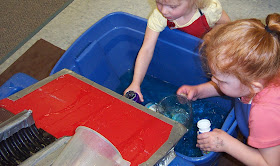I am often asked: Do you let the children build or help build an apparatus? My answer no, not at this point. Every time I am asked, though, I have to think about it again. There are two main reasons why I do not engage the children in the building of the apparatus. One reason is that I see over 100 children a week. I see them over eight classes that only meet once a week for a two hours. It is hard to create continuity between the classes; no two children are in the same class. I see what I build for the sensory table as an installation that has to be strong and secure for all the children to use during the course of a week. The second reason is selfish: I believe everyone needs a creative outlet and building apparatus for the sensory table is mine.
That said, I think that young children do need avenues to create and put things together. To that end, I added loose parts to the Channel Board this year. First of all, there was the crate that was not secure, but just sitting in the table. I thought children might take it out, but no, it became a space on which to operate and an area of focused play. Below you can see a child using the crate. He has set a funnel in the hole and is pouring water in the hole.
On the shelves next to the sensory table, there was a clear tube for which the children found many uses.


The boy on the left is using it in conjunction with the Channel Board. He has laid it in one of the channels and is pouring water in the tube for his friend to catch. The girl on the right has set the tube in the ever-present 5-gallon pail and is pouring water from the table into it.
There were also pieces of flexible tubing on the shelves that the children found and used.

On the left, boy is trying to pour the water down the clear tubing from his plastic measuring cup. That takes some precise pouring. Before long, he finds that a funnel fits nicely into the tubing (the picture on the right) and makes the job of pouring easier.
He does not stop there. He finds another bigger funnel and fits into the black funnel for more pouring fun.
The process of using the loose parts really got interesting when the children started combining them. The child pictured below is holding the flexible tubing in the mouth of the clear plastic tube to transport water from the table into the pail.
And even more intriguing was one group started to put the tubing inside the larger clear tube. That led to some original pouring operations.
Wait! Did I just make a case for the children building at the sensory table? Maybe I will have to include more loose parts from now on.






















